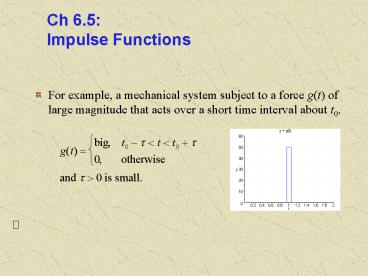Ch 6'5: Impulse Functions PowerPoint PPT Presentation
Title: Ch 6'5: Impulse Functions
1
Ch 6.5 Impulse Functions
- For example, a mechanical system subject to a
force g(t) of large magnitude that acts over a
short time interval about t0.
2
1/ Unit impulse function
- In a mechanical system, where g(t) is a force,
the total impulse of this force is measured by
the integral - Now if g(t) has the form
- then
- In particular, if c 1/(2?), then I(?) 1
(independent of ? ).
3
- Suppose the forcing function g(t) has the form (g
is called d?) - And so I(?) 1.
- Now we are interested d?(t) acting over
- shorter and shorter time intervals
- (i.e., ? ? 0, c ? inf.), but I(?) 1 !
- So d?(t) gets taller and narrower
- as ? ? 0. In this case we have
for t ? 0
anyway
4
- The unit impulse function is called ? and is
defined to have the properties - ? is usually called the Dirac delta function.
- In general, for a unit impulse at an arbitrary
point t0,
5
2/ Laplace Transform of ?
- The Laplace Transform of ? is
- For Laplace Transform of ? at t0 0, take limit
as follows
6
- Proof the Laplace Transform of ? is defined by
- and thus
7
3/ Product of Continuous Functions and ?
- The product of the delta function and a
continuous function f is - Analytical proof
8
Example 1 Initial Value Problem (1 of 3)
- Consider the solution to the initial value
problem - Then
- Letting Y(s) Ly,
- Substituting in the initial conditions, we obtain
- or
9
- We have
- The partial fraction expansion of H(s) yields
(see 6.4 ex1) - and hence
and
Plot of the Solution
10
- t lt 5 No initial conditions and no external
excitation there is no response on (0, 5). - t 5 The impulse at t 5 produces a decaying
oscillation that persists indefinitely.
Plot of the Solution
PowerShow.com is a leading presentation sharing website. It has millions of presentations already uploaded and available with 1,000s more being uploaded by its users every day. Whatever your area of interest, here you’ll be able to find and view presentations you’ll love and possibly download. And, best of all, it is completely free and easy to use.
You might even have a presentation you’d like to share with others. If so, just upload it to PowerShow.com. We’ll convert it to an HTML5 slideshow that includes all the media types you’ve already added: audio, video, music, pictures, animations and transition effects. Then you can share it with your target audience as well as PowerShow.com’s millions of monthly visitors. And, again, it’s all free.
About the Developers
PowerShow.com is brought to you by CrystalGraphics, the award-winning developer and market-leading publisher of rich-media enhancement products for presentations. Our product offerings include millions of PowerPoint templates, diagrams, animated 3D characters and more.

